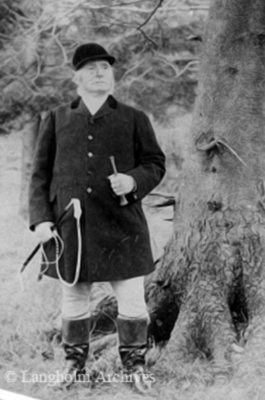E&L articles about the Eskdale Foxhounds go back to the 1850s. The organisation was sometimes described as the ‘Eskdale and Liddesdale Foxhounds’ and the ‘Eskdaill Foxhounds’ (slight spelling difference of ‘Eskdale’), perhaps to distinguish it from an ‘Eskdale’ hunt in Cumbria.

By 1913, it was under existential threat, as explained by the hunt’s master Alexander Hay-Borthwick (1862-1928), a sheep farmer at Billholm, Westerkirk parish, who resigned at a general meeting in the Crown Hotel. The E&L reported him as saying:
Owing to the lack of foxes, it was hopeless to go on hunting. He had
been all over the district, and one day rode twenty miles in snow without seeing the track of a fox.’ […] [H]e thought it would be a bad thing for the country if the small hunts were squeezed out. In that case, in twenty-five years’ time there would, he thought, be few who could ride a horse and the roads would be given over to motor cars and motor cycles.
E&L, 23 Apr 2013
During discussion at the meeting, the lack of foxes was attributed to the ‘craze for game’ (perhaps grouse shooting). The general feeling was that the hunt should be continued if possible, but unless there were more foxes it would have to be discontinued. In any event, the war disrupted the hunt’s activities.
James (‘J J’) Paterson (1883-1956) of Terrona farm, the Common Riding cornet in 1909, was elected as the new master. His father John (‘J W J’) had been an earlier master (on the right in the photo below) and also the 1850 cornet.
